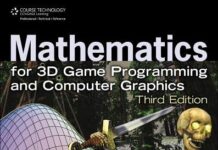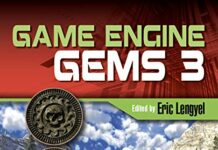
Ebook Info
- Published: 2020
- Number of pages:
- Format: PDF
- File Size: 14.93 MB
- Authors: Eric Lengyel
Description
The first volume of Foundations of Game Engine Development discusses the mathematics needed by engineers who work on games or other types of virtual simulations. The book begins with conventional treatments of topics such as linear algebra, transforms, and geometry. Then, it introduces Grassmann algebra and geometric algebra to provide a much deeper understanding of the subject matter and highlight the places where traditional arithmetic with vectors, matrices, quaternions, etc., isn’t quite correct. Includes exercises.Chapter 1: Vectors and Matrices1.1 Vector Fundamentals1.2 Basic Vector Operations1.2.1 Magnitude and Scalar Multiplication1.2.2 Addition and Subtraction1.3 Matrix Fundamentals1.4 Basic Matrix Operations1.4.1 Addition, Subtraction, and Scalar Multiplication1.4.2 Matrix Multiplication1.5 Vector Multiplication1.5.1 Dot Product1.5.2 Cross Product1.5.3 Scalar Triple Product1.6 Vector Projection1.7 Matrix Inversion1.7.1 Identity Matrices1.7.2 Determinants1.7.3 Elementary Matrices1.7.4 Inverse Calculation1.7.5 Inverses of Small MatricesChapter 2: Transforms2.1 Coordinate Spaces2.1.1 Transformation Matrices2.1.2 Orthogonal Transforms2.1.3 Transform Composition2.2 Rotations2.2.1 Rotation About a Coordinate Axis2.2.2 Rotation About an Arbitrary Axis2.3 Reflections2.4 Scales2.5 Skews2.6 Homogeneous Coordinates2.7 Quaternions2.7.1 Quaternion Fundamentals2.7.2 Rotations With QuaternionsChapter 3: Geometry3.1 Triangle Meshes3.2 Normal Vectors3.2.1 Calculating Normal Vectors3.2.2 Transforming Normal Vectors3.3 Lines and Rays3.3.1 Parametric Lines3.3.2 Distance Between a Point and a Line3.3.3 Distance Between Two Lines3.4 Planes3.4.1 Implicit Planes3.4.2 Distance Between a Point and a Plane3.4.3 Reflection Through a Plane3.4.4 Intersection of a Line and a Plane3.4.5 Intersection of Three Planes3.4.6 Intersection of Two Planes3.4.7 Transforming Planes3.5 Plücker Coordinates3.5.1 Implicit Lines3.5.2 Homogeneous Formulas3.5.3 Transforming LinesChapter 4: Advanced Algebra4.1 Grassmann Algebra4.1.1 Wedge Product4.1.2 Bivectors4.1.3 Trivectors4.1.4 Algebraic Structure4.1.5 Complements4.1.6 Antivectors4.1.7 Antiwedge Product4.2 Projective Geometry4.2.1 Lines4.2.2 Planes4.2.3 Join and Meet4.2.4 Line Crossing4.2.5 Plane Distance4.2.6 Summary and Implementation4.3 Matrix Inverses4.4 Geometric Algebra4.4.1 Geometric Product4.4.2 Vector Division4.4.3 Rotors4.5 Conclusion
User’s Reviews
Reviews from Amazon users which were colected at the time this book was published on the website:
⭐Updated again…removed my speculative errata see the books official website for errataUpdate: I have read this book all the way through a couple times now and some sections I have read repeatedly.Over those readings I have come up with some good and not so good points about the book so here they are…in no particular order…The good:1) This book is like a Lego set for 3D math. It starts with some basic pieces, then uses those pieces to build interesting 3D math parts, then uses those large pieces to build even more exotic math. Then it breaks them all down, and puts them back together to build Grassman/geometric algebra.2) The book can be educational on multiple levels, meaning that on first glance it is introducing basic stuff that you see in every book, but upon rereading I found an entire new level of detail that I missed on the first pass that aided insights to the underlying topics.3) All the stuff in the original review below. update…the books official website now has errata (thank you)Not so good:1) Some of the questions in the exercises refer to material that hasn’t been introduced yet. Like question 7 in chapter one refer’s to planes which aren’t introduced until chapter 3. There are a few place in the book this happens. Not that big a deal but still…2) The book doesn’t introduce things like converting a projection to a matrix, instead it is left as an exercise, but later in the book it uses the answer to that exercise like it was introduced. There a handful of places where the expertly crafted dialog that builds between the author and the reader break down because things like this.No matter how you slice it, this is still a 5 star book.Original review:Well edited, easy to read, and easy to follow. I’m looking forward to the next volume. This is the kind of book that keeps me passionate about computer graphics by presenting current up to date material without a bunch of redundancy. It also offers a tantalizing look into grassman/geometric algebra complete with enough implementation details to start putting the theory to use. I’m hoping the author will continue to explore this area in the other volumes of the book. (using the wedge operator with sphere’s in particular) If there is anything I didn’t really care for its that I felt like I was being led somewhere with the overall structure of the book and the code listings that it includes. But at the end of the book it seemed like some of these ideas were either just dropped or left up to the reader to conjure from the tables. The author recommends reading chapter 3 for experienced readers, but I would suggest starting in chapter 2, if you start falling asleep go to chapter 3 if you are lost go back to chapter 1, if chapter 1 is confusing then…segmentation fault, core dumped
⭐I am a game developer at a triple A studio. Although the book was hard, I read and reread it so thoroughly that it helped me really grasp the fundamentals of linear algebra. In fact, the introduction to Geometric algebra (in the last chapter) gave me the tools to be able to reconstruct the learnings from the rest of the book. It taught me a lot of new things and it deepened my understanding of the things I already knew. It really boosted the confidence in my math skills and already it has greatly impacting my professional career.There are a few sections that I thought were too hard. Sometimes a conclusion is given but I wasn’t able to work out the proof with the things I was taught. So in addition I spent quite a lot of time digging through study material on the web from other sources to teach me enough to do it. Those brain-wreckers are perhaps a weakness to the book, but if you refuse to give up it does make the lessons stick a lot better.I did however give up the second halve of questions provided at the end of chapter 3. I couldn’t understand the answers in the solution guide no matter how much I learned and I felt it wasn’t very fruitful to do so. It’s the set of questions about Plücker coordinates. The tools handed in chapter 4 give a better intuition to the problems, so I recommend revisiting those questions after you finished the book.I’ve ordered part 2 and can’t wait for 3 and 4 to release.This book teaches you some math that none of my colleagues knew about, and that includes 2 people with a PhD in Mathematics. I assure you though, knowing this is a tool in your belt that gives you an advantage that you won’t easily forget about.
⭐This book is good if you want to understand the math and what it is used for, but it is not applied enough for a person who wants to develop games. Figures are only present for concepts so simple that you do not need figures, for rotation for example. And many of the exercises ask you to prove something, which is only useful if you are a pure mathematician. And the “code included” part? It just puts into code the equations the book has already given you. For example – quaternions. They give me code that produces a quaternion. What I need is code that uses a quaternion. A better book than this on the same subject is David Rogers’ Mathematical Elements for Computer Graphics. I bought it in1992 and to this day no book written since then can replace it. Dunn and Parberry’s “3D Math Primer for Graphics and Game Development” is a good modern book if you can’t find the Rogers tome. But look out for modern print quality, which is reported to be abysmal.
⭐This book is must in game programming.
⭐I haven’t had linear algebra since AP classes in high school. This is a great refresher if you’re trying to understand 3d game engines. I don’t speak C++ but the code examples are fairly easy to follow along if you speak some sort of C-style language.
⭐I was hoping for more code to understand the math notations. After all it should be a programmers guide.
⭐Ordered on 17 Jan 2020, and the book was printed the same day in San Bernadino valley California. Arrived within a day, Amazing!
⭐Great!
⭐A dense yet intuitively presented guide to some of the trickiest bits of vector math one is likely to come across during game development, with a brief but fascinating discursion into Lengel’s real passion — geometric algebra — at the end.I suspect an aspiring game developer would get fatigued quickly by this book. It would not make a good introduction to the math involved in games. This is a great book for people who regularly *use* vector math, but want to really *understand* it at a deeper level.
⭐As a game technology student, this book has helped me a lot in creating a math library from scratch, and also in a deeper understanding of linear algebra. The last chapter – advanced algebra – delves into things like why the cross product is defined like it is, and why determinants are defined like they are. The book generally gives clear logic of where proofs and concepts come from, and it provides great illustrations of these concepts. Overall, this book has given me a better intuition on the mathematics behind game engines.
⭐Very good printing quality, organization and scope. Perfect to learn the math required for game engines (2D & 3D).
⭐the first Math book that is not intimidating!good quality small enough to take were ever you go but bursting with info and the print quility is good!i plan to get the whole collection as there released.
⭐Really helped me learn a lot, and was surprisingly simple to understand! Totally recommend for people interested in the math behind games.
Keywords
Free Download Foundations of Game Engine Development, Volume 1: Mathematics in PDF format
Foundations of Game Engine Development, Volume 1: Mathematics PDF Free Download
Download Foundations of Game Engine Development, Volume 1: Mathematics 2020 PDF Free
Foundations of Game Engine Development, Volume 1: Mathematics 2020 PDF Free Download
Download Foundations of Game Engine Development, Volume 1: Mathematics PDF
Free Download Ebook Foundations of Game Engine Development, Volume 1: Mathematics



